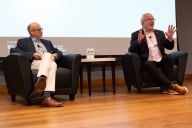You have /5 articles left.
Sign up for a free account or log in.
With all eyes on the Arab Spring, a revolution on American soil is going largely ignored. After four decades of estrangement from the U.S. military, elite universities are reopening their doors to the Reserve Officer Training Corps. At hand is an unprecedented opportunity to repair relations between America’s military and the society it protects. For ROTC’s return to be more than symbolic, however, university and military leaders must move beyond handshakes and start building real bridges.
Vietnam-era walls have been crumbling since Congress voted in December to repeal “don’t ask, don’t tell.” Last Thursday, the Yale faculty removed a set of resolutions that precipitated ROTC’s dismissal over forty years ago. Two weeks ago, the Stanford faculty voted to invite ROTC back to campus. Harvard and Columbia were the first institutions to revise their policies and have already struck new agreements with the U.S. Navy. Among the Ivies without ROTC programs, only Brown has yet to make its intentions clear.
This trend at America’s top universities confirms that the rift between American citizens and their military is neither preferable nor permanent. The military has been the most trusted institution in America for over a decade, but less than 1 percent of Americans currently serve, and an increasingly disproportionate number of recruits hail from the South. Today, most Americans “support the troops” without actually knowing them. This affliction is especially acute at America’s elite universities, where students have little outside of Hollywood to inform their perceptions of military life.
To be sure, America’s civil-military divide cannot be fixed by strengthening university-military ties alone. More comprehensive measures might broaden the definition of service and compel, through requirements or incentives, a more representative cross-section of American society to serve their country. Still, if given the attention it deserves, ROTC’s homecoming can provide the civil-military reintroduction that America wants and so badly needs.
For its part, the Department of Defense must commit the resources necessary to grow fledgling ROTC programs at elite universities. These programs will never approach the size of ROTC programs at larger universities in the South, but the U.S. military already preferences quality over quantity in its service academies, whose cadets cost three to four times as much to educate as their ROTC counterparts. For the cost of three miles of highway in Afghanistan, the Department of Defense could open five ROTC programs.
Investing in ROTC at elite universities also means sending talented junior officers to get new programs off the ground. This is not to say that elite universities are entitled to better ROTC instructors than elsewhere, only that they will need them during their critical first years. Officers reluctant to take up residence in the Ivory Tower’s most exclusive enclaves should consider Stanley McChrystal’s success teaching at Yale and Gen. David Petraeus’s experience studying counterinsurgency strategy for his Ph.D. at Princeton.
For their part, elite universities must start treating military service as an equal profession. Universities already embrace national service programs like Teach for America, encouraging students to apply and reporting with special pride the numbers of their alumni in such programs. They should do the same with military service. University career centers should host panels about military service, as they do for other professions, and offer to connect students with alumni who have pursued military careers. Student advisers should become more familiar with the military’s career tracks. It will come as a shock to many students that they can serve their country from the courtroom or the operating table.
Fewer places are better than the classroom for building civil-military bonds. When possible, faculty should collaborate with ROTC instructors. Imagine how an East Asian politics class might benefit from the experience of a naval officer who has been deployed throughout the region. Knowing only about the military as a fighting force, many students will be surprised by the intellectual firepower wielded by America’s men and women in uniform. This is not the militarization of education, it is civic engagement 101.
Like the Arab Spring, ROTC’s return to elite campuses is anything but a foregone conclusion. What is certain is that the world has changed, and opportunities to shape a better future are present but fleeting. ROTC is coming home, but university and military leaders must decide how they will live together. They alone will determine whether this is the American Spring for civil-military relations, or just a flash in the pan.






